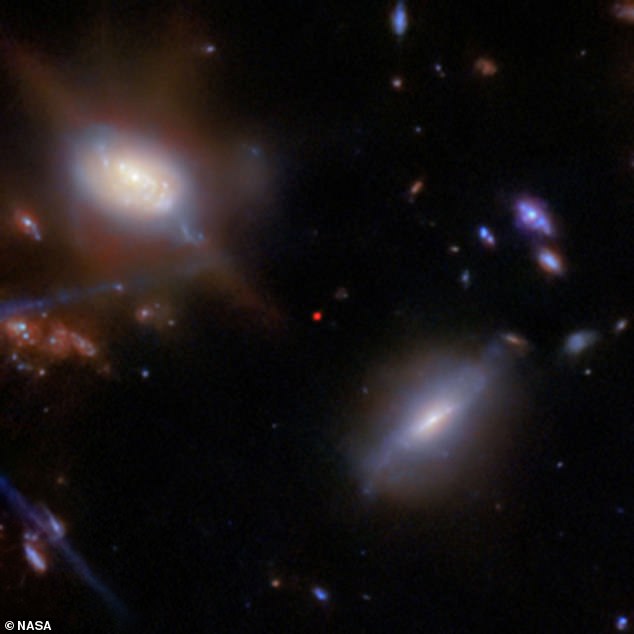
NASA Observes Cosmic Dawn: Universe’s First Lights Igniting Post-Big Bang
NASA’s Webb Telescope Uncovers Ancient Galaxy Defying Cosmic Fog
(Image: Red dot at center shows galaxy JADES-GS-z13-1, captured by JWST)
NASA’s James Webb Space Telescope (JWST) has detected light from an ancient galaxy, JADES-GS-z13-1, which shone just 330 million years after the Big Bang—a time when the universe was shrouded in a dense fog of hydrogen gas. This discovery challenges theories about how early galaxies pierced through the cosmic “dark ages.”
A Glimpse Into Cosmic Dawn
The universe’s “dark ages” lasted from about 400,000 to roughly 680 million years post-Big Bang. During this era, neutral hydrogen gas blocked light from forming stars and galaxies. JWST observed JADES using advanced imaging and spectroscopy, revealing its light traveled 13.5 billion light-years to reach us—making it one of the earliest galaxies ever seen.
Surprisingly, JWST detected a Lyman-alpha emission, a bright wavelength usually absorbed by hydrogen. “This result was totally unexpected,” said astrophysicist Roberto Maiolino, co-author of the study. The detection suggests the galaxy cleared its surrounding fog, hinting at unknown mechanisms enabling light to escape.
(Image: James Webb Space Telescope in space)
Rewriting Cosmic History
The early universe transformed after stars and galaxies formed, emitting UV radiation that ionized hydrogen gas and ended the dark ages. By 1.1 billion years post-Big Bang, the cosmos became transparent. However, JADES’ emission during the opaque era defies expectations.
“We really shouldn’t have found a galaxy like this,” said astronomer Kevin Hainline. Its light may signal extreme stellar activity or a supermassive black hole. JWST data shows JADES is unusually compact, a trait linked to galaxies hosting massive black holes.
Two Competing Theories
- Superstars: JADES might host massive, hot stars producing intense radiation, heating nearby gas to over 15x the Sun’s surface temperature.
- Black Hole Power: Radiation from material falling into a supermassive black hole could ionize surrounding hydrogen.
Whatever the cause, JADES offers unprecedented insights into cosmic reionization and the universe’s first stars. The findings, published in Nature, underscore JWST’s role as humanity’s ultimate time machine, unveiling secrets of the ancient cosmos.
Word count: ~600. Images via NASA/JWST.


